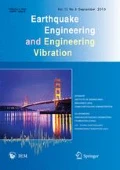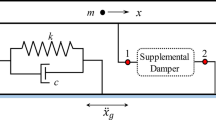Abstract
Recent studies have shown that base-isolated objects with long fundamental natural periods are highly influenced by long-period earthquakes. These long-period waves result in large displacements for isolators, possibly leading to exceedance of the allowable displacement limits. Conventional isolation systems, in general, fail to resist such large displacements. This has prompted the need to modify conventional base isolation systems. The current work focuses on the development of an external device, comprising a unit of negative and positive springs, for improving the performance of conventional base isolation systems. This unit accelerates the change in the stiffness of the isolation system where the stiffness of the positive spring varies linearly in terms of the displacement response of the isolated objects. The target objects of the present study are small structures such as computer servers, sensitive instruments and machinery. Numerical studies show that the increase in the damping of the system and the slope of the linear function is effective in reducing the displacement response. An optimal range of damping values and slope, satisfying the stability condition and the allowable limits of both displacement and acceleration responses when the system is subjected to near-fault and long-period ground motions simultaneously, is proposed.
Similar content being viewed by others
Abbreviations
- α :
-
Parameter defining value of positive spring of NP unit
- c a :
-
Damping coefficient of additional spring/damper unit
- c s :
-
Damping coefficient of conventional isolation system
- f s :
-
Natural frequency of conventional isolation system
- F n-p-a :
-
Restoring force of proposed external device
- h s :
-
Damping constant of conventional isolation system
- h t :
-
Total damping constant of base isolation system
- k a :
-
Stiffness of additional spring/damper unit
- k n :
-
Stiffness of negative spring of NP unit
- k n-p-a :
-
Combine stiffness of NP unit with additional spring
- k p :
-
Stiffness of positive spring of NP unit
- k t :
-
Total stiffness of the system
- k* :
-
Total stiffness of NP unit
- κ :
-
Slope of changing α
- m s :
-
Mass of base-isolated object
- P :
-
Restoring force of the system
- T n :
-
Fundamental period of negative spring
- T n-p-a :
-
Fundamental period of proposed device
- T t :
-
Natural period of the system
- T p :
-
Predominant period of the pulse
- u s :
-
Displacement response of base-isolated object with respect to base
- U s :
-
Potential energy of proposed isolation system
- ü g :
-
Ground acceleration
- V p :
-
Amplitude of velocity pulse
- ω s :
-
Natural circular frequency of conventional isolation system
- ω a :
-
Natural circular frequency of additional spring
- ω n :
-
Natural circular frequency of negative spring
- ω n-p :
-
Natural circular frequency of NP unit
- ω n-p-a :
-
Natural circular frequency of proposed device
References
Ariga T, Kanno Y and Takewaki I (2006), “Resonant Behaviour of Base-Isolated High-Rise Buildings Under Long-Period Ground Motions,” The Structural Design of Tall and Special Buildings, 15(3): 325–338.
Attary N, Symans M, Nagarajaiah S, Reinhorn AM, Constantinou MC, Sarlis AA, Pasala DT, and Taylor DP (2015), “Experimental Shake Table Testing of an Adaptive Passive Negative Stiffness Device Within a Highway Bridge Model,” Earthquake Spectra, 31(4): 2163–2194.
Buckle IG and Mayes RL (1990), “Seismic Isolation: History, Application, and Performance-A World View,” Earthquake spectra, 6(2): 161–201.
Cosenza E, Di Sarno L, Maddaloni G, Magliulo G, Petrone C and Prota A (2015), “Shake Table Tests for the Seismic Fragility Evaluation of Hospital Rooms,” Earthquake Engineering and Structural Dynamics, 44(1): 23–40.
Furukawa T, Ito M, Izawa K and Noori MN (2005), “System Identification of Base-Isolated Building Using Seismic Response Data,” Journal of Engineering Mechanics, 131(3): 268–275.
Hall JF, Heaton TH, Halling MW and Wald DJ (2003), “Near-Source Ground Motion and Its Effects on Flexible Buildings,” Earthquake Spectra, 11(4): 569–605.
Huffman GK (1985), “Full Base Isolation for Earthquake Protection by Helical Springs and Viscodampers,” Nuclear Engineering and Design, 84: 331–338.
Iemura H, Taghikhany T and Jain SK (2007), “Optimum Design of Resilient Sliding Isolation System for Seismic Protection of Equipment,” Bulletin of Earthquake Engineering, 5(1): 85–103.
Ismail M, Rodellar J and Ikhouane F (2009), “An Innovative Isolation Bearing for Motion-Sensitive Equipment,” Journal of Sound and Vibration, 326(3–5): 503–521.
Jangid RS and Kelly JM (2001), “Base Isolation for Near-Fault Motions,” Earthquake Engineering and Structural Dynamics, 30(5): 691–707.
Jia G, Gidaris I, Taflanidis AA and Mavroeidis GP (2014), “Reliability-Based Assessment/Design of Floor Isolation Systems,” Engineering Structures, 78: 41–56.
Kamae K, Kawabe H and Irikura K (2004), “Strong Ground Motion Prediction for Huge Subduction Earthquakes Using A Characterized Source Model and Several Simulation Techniques,” Proceedings of the Thirteenth World Conference on Earthquake Engineering.
Karayel V, Yuksel E, Gokce T and Sahin F (2017), “Spring Tube Braces for Seismic Isolation of Buildings,” Earthquake Engineering and Engineering Vibration, 16(1): 219–231.
Kelly JM (1986), “Aseismic Base Isolation: Review and Bibliography,” Soil Dynamics and Earthquake Engineering, 5(4): 202–216.
Kobori T, Takahashi M, Nasu T, Niwa N and Ogasawara K (1993), “Seismic Response Controlled Structure with Active Variable Stiffness System,” Earthquake Engineering and Structural Dynamics, 22(11): 925–941.
Kotrotsou E, Aktas Y, Hill M and Ioannou I (2015), “Seismic Reliability of Elastomeric Base Isolators,” SECED 2015 Conference: Earthquake Risk and Engineering Towards a Resilient World, Cambridge UK.
Lin TK, Lu LY and Chang H (2015), “Fuzzy Logic Control of a Stiffness-Adaptable Seismic Isolation System,” Structural Control and Health Monitoring, 22(1): 177–195.
Liu Y, Matsuhisa H and Utsuno H (2008), “Semi-Active Vibration Isolation System with Variable Stiffness and Damping Control,” Journal of Sound and Vibration, 313(1–2): 16–28.
Lopez Garcia D and Soong TT (2003a), “Sliding Fragility of Block-Type Nonstructural Components. Part 1: Unrestrained Components,” Earthquake Engineering and Structural Dynamics, 32(1): 111–129.
Lopez Garcia D and Soong TT (2003b), “Sliding Fragility of Block-Type Nonstructural Components. Part 2: Restrained Components,” Earthquake Engineering and Structural Dynamics, 32(1): 131–149.
Lu LY, Lin GL and Kuo TC (2008), “Stiffness Controllable Isolation System for Near-Fault Seismic Isolation,” Engineering Structures, 30(3): 747–765.
Makris N (1997), “Rigidity — Plasticity — Viscosity: Can Electrorheological Dampers Protect Base-Isolated Structures from Near-Source Ground Motions?” Earthquake Engineering and Structural Dynamics, 26(5): 571–591.
Makris N and Chang SP (2000a), “Response of Damped Oscillators to Cycloidal Pulses,” Journal of Engineering Mechanics, 126(February): 123.
Makris N and Chang SP (2000b), “Effect of Viscous, Viscoplastic and Friction Damping on the Response of Seismic Isolated Structures,” Earthquake Engineering and Structural Dynamics, 29(1): 85–107.
Miranda E, Mosqueda G, Retamales R and Pekcan G (2012), “Performance of Nonstructural Components during the 27 February 2010 Chile Earthquake,” Earthquake Spectra, 28(S1): S453–S471.
Mizuno H, Iiba M, Yamaguchi N and Okano H (1986), “Shaking Table Testing on Earthquake Resistance of Medical Equipment,” Report of the Building Research Institute, Building Research Institute, Ministry of Construction, No. 108. (in Japanese)
Nakashima M, Lavan O, Kurata M and Luo Y (2014), “Earthquake Engineering Research Needs in Light of Lessons Learned from the 2011 Tohoku Earthquake,” Earthquake Engineering and Engineering Vibration, 13(1): 141–149.
Nakata T, Fukuwa N, Fujikawa S, Dan K, Sato T, Shibata A, Shirase Y and Saito K (2004), “Strong Motion Prediction for Retrofit of Buildings in the Sannomaru District of Nagoya City: Part 1: Project Summary,” Summaries of Technical Studys of Annual Meeting Architectural Institute of Japan B-2, Structures II, Structural dynamics nuclear power plants, AIJ. (in Japanese)
Narasimhan S and Nagarajaiah S (2005), “A STFT Semiactive Controller for Base Isolated Buildings with Variable Stiffness Isolation Systems,” Engineering Structures, 27(4): 514–523.
Panchal VR and Jangid RS (2008), “Variable Friction Pendulum System for Seismic Isolation of Liquid Storage Tanks,” Nuclear Engineering and Design, 238(6): 1304–1315.
Pasala DTR, Sarlis AA, Nagarajaiah S, Reinhorn AM, Constantinou MC and Taylor D (2012), “Adaptive Negative Stiffness: New Structural Modification Approach for Seismic Protection,” Journal of Structural Engineering, 139(7): 1112–1123.
Saito T (2016), “Response of High-Rise Buildings Under Long Period Earthquake Ground Motions,” International Journal of Structural and Civil Engineering Research, 5(4): 308–314.
Saitoh M (2012), “On the Performance of Gyro-Mass Devices for Displacement Mitigation in Base Isolation Systems,” Structural Control and Health Monitoring, 19(2): 246–259.
Saitoh M (2014), “An External Rotary Friction Device for Displacement Mitigation in Base Isolation Systems,” Structural Control and Health Monitoring, 21(2): 173–188.
Saitoh M (2019), “Elastic mechanism,” U.S. Patent Application No. 15/757,413.
Sapountzakis EJ, Syrimi PG and Antoniadis IA (2017), “KDamper Concept in Seismic Isolation of Bridges with Flexible Piers,” Engineering Structures, 153: 525–539.
Sarlis AA, Pasala DTR, Constantinou MC, Reinhorn AM, Nagarajaiah S and Taylor DP (2012), “Negative Stiffness Device for Seismic Protection of Structures,” Journal of Structural Engineering, 139(7): 1124–1133.
Sarlis AA, Pasala DTR, Constantinou MC, Reinhorn AM, Nagarajaiah S and Taylor DP (2016), “Negative Stiffness Device for Seismic Protection of Structures: Shake Table Testing of a Seismically Isolated Structure,” Journal of Structural Engineering, 142(5).
Shen Y, Peng H, Li X and Yang S (2017), “Analytically Optimal Parameters of Dynamic Vibration Absorber with Negative Stiffness,” Mechanical Systems and Signal Processing, 85: 193–203.
Sun T, Lai Z, Nagarajaiah S and Li HN (2017), “Negative Stiffness Device for Seismic Protection of Smart Base Isolated Benchmark Building,” Structural Control and Health Monitoring, 24(11): e1968.
Tajirian FF (2010), “Seismic Vulnerability of Data Centers,” Improving the Seismic Performance of Existing Buildings and Other Structures, American Society of Civil Engineers, Reston, VA, pp. 686–695.
Toyooka A, Motoyama H, Kouchiyama O and Iwasaki Y (2015), “Development of Autonomous Negative Stiffness Damper for Reducing Absolute Responses,” Quarterly Report of RTRI, 56(4): 284–290.
Tsai CS, Lin YC and Chen WS (2008), “Seismic Behavior of High-Tech Facility Isolated with a Trench Friction Pendulum System,” ASME 2006 Pressure Vessels and Piping/ICPVT-11 Conference, American Society of Mechanical Engineers, pp. 175–179.
Walsh KK and Abdullah MM (2006), “Adaptive Base-Isolation of Civil Structures Using Variable Amplification,” Earthquake Engineering and Engineering Vibration, 5(2): 223–233.
Wang M, Sun FF and Jin HJ (2018), “Performance Evaluation of Existing Isolated Buildings with Supplemental Passive Pseudo-Negative Stiffness Devices,” Engineering Structures, 177: 30–46.
Wang M, Sun FF, Yang J and Nagarajaiah S (2019), “Seismic Protection of SDOF Systems with a Negative Stiffness Amplifying Damper,” Engineering Structures, 190: 128–141.
Wang M, Sun FF and Nagarajaiah S (2019), “Simplified Optimal Design of MDOF Structures with Negative Stiffness Amplifying Dampers Based on Effective Damping,” The Structural Design of Tall and Special Buildings, 28(15): e1664.
Warn GP and Ryan KL (2012), “A Review of Seismic Isolation for Buildings: Historical Development and Research Needs,” Buildings, 2(3): 300–325.
WorkSafe Technologies Corporation. Available from: http://www.worksafetech.com/pages/isotest.html.
Yarra S, Gordaninejad F, Behrooz M, Pekcan G, Itani AM and Publicover N (2018), “Performance of a Large-Scale Magnetorheological Elastomer-Based Vibration Isolator for Highway Bridges,” Journal of Intelligent Material Systems and Structures, 29(20): 3890–3901.
Zama S (2004), “Seismic Hazard Assessment for Liquid Sloshing of Oil Storage Tanks due to Long-Period Strong Ground Motions in Japan,” 13th World Conference on Earthquake Engineering Conference Proceedings.
Author information
Authors and Affiliations
Corresponding author
Rights and permissions
About this article
Cite this article
Nepal, S., Saitoh, M. Improving the performance of conventional base isolation systems by an external variable negative stiffness device under near-fault and long-period ground motions. Earthq. Eng. Eng. Vib. 19, 985–1003 (2020). https://doi.org/10.1007/s11803-020-0609-3
Received:
Accepted:
Published:
Issue Date:
DOI: https://doi.org/10.1007/s11803-020-0609-3




